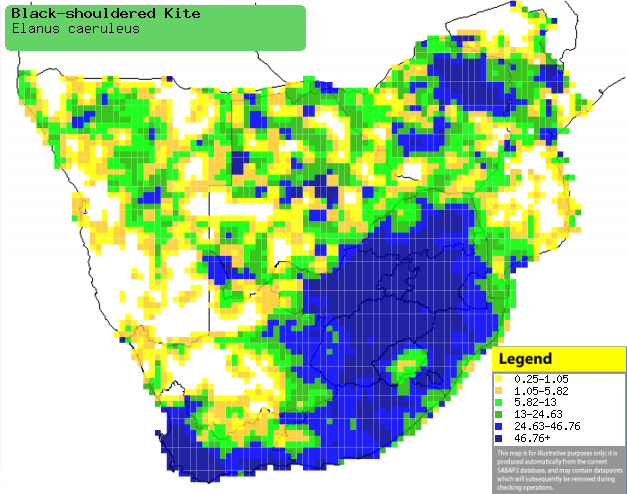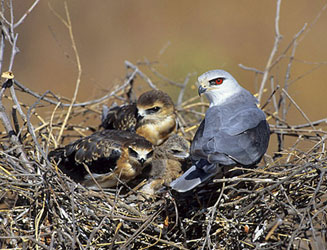|
Elanus caeruleus
(Black-shouldered kite)
Blouvalk [Afrikaans]; Umdlampuku, Unongwevana [Xhosa]; Tuyu
(also applied to Dickinson's kestrel) [Kwangali]; Phakoana-mafieloana,
Phakoana-tooana, Phakoana-toana [South Sotho]; Rukodzi (generic name
for a small raptor such as falcon or sparrowhawk) [Shona]; Lohheyane
(generic term for small hawks) [Swazi]; Nwarikapanyana [Tsonga];
Phakalane, Segôôtsane (generic terms for some of the smaller raptors)
[Tswana]; Grijze wouw [Dutch]; Élanion blanc [French]; Gleitaar [German];
Peneireiro-cinzento [Portuguese]
Life
> Eukaryotes >
Opisthokonta
> Metazoa (animals) >
Bilateria >
Deuterostomia > Chordata >
Craniata > Vertebrata (vertebrates) > Gnathostomata (jawed
vertebrates) > Teleostomi (teleost fish) > Osteichthyes (bony fish) > Class:
Sarcopterygii (lobe-finned
fish) > Stegocephalia (terrestrial
vertebrates) > Tetrapoda
(four-legged vertebrates) > Reptiliomorpha > Amniota >
Reptilia (reptiles) >
Romeriida > Diapsida > Archosauromorpha > Archosauria >
Dinosauria
(dinosaurs) > Saurischia > Theropoda (bipedal predatory dinosaurs) >
Coelurosauria > Maniraptora > Aves
(birds) > Order: Falconiformes
> Family: Accipitridae
Distribution and habitat
Occurs in India, South-East Asia, south-western Europe and
across sub-Saharan Africa, from southern Mauritania to Eritrea south to southern
Africa. Here it is very common across the region, especially in South Africa,
north-eastern Zimbabwe and central Botswana. It occurs in most habitats, but
generally prefers grassland, transformed fynbos and cultivated land. It is
largely absent from closed woodland, forest and desert.
|
 |
|
Distribution of Black-shouldered kite in southern
Africa, based on statistical smoothing of the records from first SA Bird
Atlas Project (©
Animal Demography unit, University of
Cape Town; smoothing by Birgit Erni and Francesca Little). Colours range
from dark blue (most common) through to yellow (least common).
See here for the latest distribution
from the SABAP2. |
Predators and parasites
It has been recorded as prey of the following animals:
Movements and migrations
Resident and nomadic, sometimes moving from
southern Africa to the tropics; females are
generally more nomadic than males.
Food
It mainly eats rodents, often hunting by hovering in the
air, searching for prey. Once it has an animal singled out, it drops to the
ground to grab its prey. It also hunts from a perch, flying from one position
to another before diving to the ground.
Hover-hunting is less energy efficient but slightly more successful than hunting
from a perch, also allowing it to forage in areas without perches. The following food items have been recorded
in its diet:
- Vertebrates
- Invertebrates
Breeding
- Monogamous, territorial solitary nester, with females selecting male based
on the quality of his territory.
- The nest (see image below) is built by both sexes in about 10-13 days,
consisting of a flimsy platform of sticks lined with dry grass, usually
about 30 cm wide and 7-10 cm deep. It is typically placed as high as
possible in the tree canopy, often in Acacia or another thorny tree
but sometimes an alien tree such as Eucalyptus or pine (Pinus).
It may also use man-made structures, such as power pylons and utility poles.
 |
|
|
Black-shouldered kite at its nest with two chicks,
Nylsvley, South Africa. [photo
Warwick Tarboton ©] |
|
- Egg-laying season is year-round, peaking from July-November in the Western
and Eastern Cape and from March-April elsewhere.
- It lays 2-6 eggs, which are mainly incubated by the female for about
30-33 days.
- The chicks are brooded by the female for the first 14 days or so of
their lives, while the male does all the hunting, handing food to the female
who then feeds the chicks. The young make their first flights at about 33-37
days old, remaining in the nest for another six days or so. They become
fully independent about 42-70 days later. The parents vigorously defend the
nest, repeatedly attacking intruders, such as humans.
Threats
Not threatened, in fact it has greatly benefited from
agriculture, bush clearance and the introduction of alien trees, which are used for nesting
in otherwise treeless areas.
References
-
Hockey PAR, Dean WRJ and Ryan PG 2005. Roberts
- Birds of southern Africa, VIIth ed. The Trustees of the John Voelcker
Bird Book Fund, Cape Town.
|
